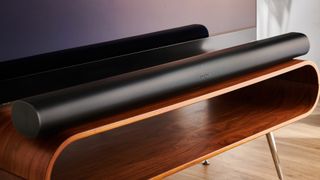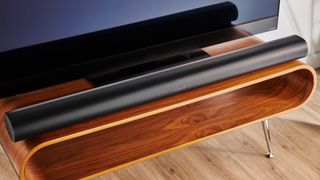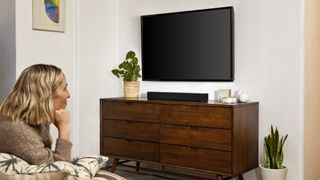Sonos Arc vs Sonos Beam: which soundbar is best for you?
The Sonos soundbars do battle

Sonos is one of the biggest names in wireless home audio solutions, and its soundbars are among the best you can buy.
Earlier this year, the audio brand released the Sonos Arc, a streamlined soundbar that offers Dolby Atmos immersive sound in a compact package, all while sitting squarely in Sonos’ clever multi-room audio ecosystem.
Thanks to its seamless design, amazing surround sound-style audio, and easy setup, we crowned it the best soundbar of 2020.
However, it’s not the only Sonos soundbar you should consider, particularly if you’re on a budget. Launched in 2018, the Sonos Beam is far cheaper than the Arc, and better suited to smaller rooms, with a compact build and slick design.
While it doesn’t come with high-spec features like Dolby Atmos and DTS:X, the Beam is still well worth considering if you’re looking for a budget friendly bar to boost your home cinema setup.
Not sure which soundbar is best for you? We’ve compared all the best features of both Sonos speakers to make your buying decision a little easier – but first, let’s take a look at some of the reasons you should think about buying a soundbar in the first place.
- Read our Sonos Arc review
- Or, check out our Sonos Beam review
Why should I buy a soundbar?
Whether you’re a serious cinephile or a Netflix addict, a soundbar is a must-have device to accompany today’s TVs.
Get daily insight, inspiration and deals in your inbox
Get the hottest deals available in your inbox plus news, reviews, opinion, analysis and more from the TechRadar team.
That’s because, as the best TVs become slimmer and slimmer, there’s simply less space for built-in speakers – and that means the audio coming from your TV can sound tinny and weak.
Sure, you could boost your TV’s audio with a complicated surround sound setup, but if you’re looking for an all-in-one solution, a soundbar is your best bet. These long, slim speakers sit beneath your TV’s display, making them an ideal choice for smaller rooms that wouldn’t be able to comfortably accommodate a 7.1 channel speaker system.
If you do want the full surround sound experience however, many soundbars today come with wireless subwoofers and rear speakers – while Dolby Atmos-enabled speakers use upfiring tweeters or clever digital signal processing to give your TV’s sound a cinematic sense of height and width.
Soundbars can also be used for gaming, or to simply play music via Bluetooth – and in the case of Sonos soundbars like the Arc and the Beam, they can form part of a huge multi-room audio setup with other wireless speakers, allowing you to blast music in every inch of your home.
What’s good about the Sonos Arc?

Dolby Atmos, True HD, and Dolby Digital Plus
The Sonos Arc draws on Dolby’s latest TrueHD and Dolby Digital Plus sound codecs to deliver the best quality lossless audio found on cutting edge Blu-ray disks and some of the leading streaming services. It then enhances the 3D soundscape using Dolby Atmos object tracks to bounce certain sounds off the walls around you so they feel like they’re coming at you from all angles. That makes the Arc a great choice if you typically watch big blockbusters on the small screen, making you feel as if you’re in a cinema.
Speakers: 5.0.2, 11 Class-D amplifiers, 8 woofers, 3 tweeters
Dimensions: 45 x 3.4 x 4.5 inches (1141.7 x 87 x 115.7mm), 13.78 lbs (6.25 kg )
Finish: Matte Black or White
Connections: HDMI input (ARC), optical digital audio to HDMI converter, Bluetooth, Ethernet port, 802.11b,g Wi-Fi, Apple AirPlay 2, IR receiver
App: Android (no Trueplay), iOS
Voice Assistant: Alexa, Google Assistant
Subwoofer included: No
Unmatched audio quality
The Sonos Arc contains 11 high quality drivers, which work together to deliver everything from powerful warm bass to clean and precise high notes during both music and media playback. Better still, it can do all this while mimicking the soundscape of true multi-speaker surround sound. This audio is also adapted to your room, thanks to Sonos’ proprietary TruePlay technology.
Trueplay is Sonos’ proprietary adaptive soundscape tool which analyzes the shape of a room in order to best balance the sound output for everyone in it. There is one pretty considerable hitch, however: Trueplay is only compatible with iOS devices, so you’ll need to borrow a friend’s iPhone or iPad to complete this part of the setup.
Simple design
The Sonos Arc is ideal for anyone who’s put off by complicated setups, having only two essential inputs: a power cable and a HDMI in (while an Ethernet socket and a Digital Optical to HDMI adapter are available out of the box, it’s only recommended you use them if you absolutely have to). Sonos doesn’t even include a remote, suggesting you instead connect the soundbar to your TV via the Audio Return Channel (ARC) and just use your TV remote or control it through the new Sonos S2 smartphone app.
It looks good, too; coming in black or white, its simple wraparound grille is only broken up by a subtle Sonos logo, as well as an LED that lights up when you change the volume. On the top of the soundbar, you’ll find play/pause, mute, and volume buttons. A word to the wise, though: it’s a little taller than many soundbars, so if your TV sits very low, you may find it obscures the IR sensor on your display. Luckily, it can be wall-mounted if this is an issue.
What’s good about the Sonos Beam?

Compact design
The Sonos Beam is a soundbar that will happily sit in front of a 32-inch set up or a 40-inch plus TV, and its slick design means it will look great in even the tightest places, whether you place it in front of your TV or mount it on the wall.
With a height of 100mm, it shouldn’t block your TV’s IR sensor – unlike the Sonos Arc.
Speakers: 3.0, 4 full-range woofers, 1 tweeter, 3 passive radiators, 5 Class-D digital amplifiers
Dimensions: 2.70 x 25.625 x 3.94 in. (68.5 x 651 x 100 mm), 6.2 lbs (2.8 kg)
Finish: Matt Black or White
Connections: 1 x Digital Optical-In, 1 x HDMI ARC 10/100Mpbs Ethernet port, Wi-Fi, Apple AirPlay 2, IR receiver App: Android (no Trueplay), iOS
Voice Assistant: Alexa, Google Assistant
Subwoofer included? No
Cheaper price
The Sonos Beam was launched at $399 / £399 / AU$599 – now, that might not sound super cheap, but compared to the Sonos Arc’s $799 / £799 / AU$1,399 price tag, it’s positively frugal.
Plus, it comes with many of the same features as its pricier sibling, including Alexa and Google Assistant voice control built-in, TruePlay room calibration, and HDMI ARC compatibility.
Now that the Sonos Beam is a little older, it’s common to find discounts – and with Amazon Prime Day and Black Friday 2020 coming up, you can expect that price to drop even further over the next few months.
Superb sound for the size
It may not have the Dolby Atmos smarts of the Sonos Arc, but the Sonos Beam still packs a serious audio punch, particularly when you consider its compact build. The Sonos Beam is designed for three-channels, but it can nearly make those three channels sound almost like true surround sound thanks to the Trueplay software we mentioned earlier.
- Too pricey? Check out the best soundbar deals we've found today
Verdict
Whichever of these two soundbars you go for, you can be sure that you’ll be buying a fantastic product. That’s because both the Sonos Arc and the Sonos Beam offer superb sound quality, good connectivity options, great design, and built-in voice control courtesy of Google Assistant and Amazon’s Alexa.
Both soundbars also slot into Sonos’ seamless multi-room audio system, which is all controllable via a simple app.
Making your choice should come down to two main areas: price, and space. If you’re on a budget, the Sonos Beam is a great option, boasting many of the same features (but not all) as the Arc, which costs $400 / £400 / AU$800 more.
It’s also far smaller, making it ideal for cramped spaces, or for use with smaller TVs.
Want to go all-out and have a little money to spend? Go for the Sonos Arc. It offers superior sound quality, immersive Dolby Atmos, and it’s big enough to make a real sonic impact when you’re watching a film – after all, it’s the best soundbar of 2020 for a reason.
- Looking for more? These are the best soundbars of 2020
Olivia was previously TechRadar's Senior Editor - Home Entertainment, covering everything from headphones to TVs. Based in London, she's a popular music graduate who worked in the music industry before finding her calling in journalism. She's previously been interviewed on BBC Radio 5 Live on the subject of multi-room audio, chaired panel discussions on diversity in music festival lineups, and her bylines include T3, Stereoboard, What to Watch, Top Ten Reviews, Creative Bloq, and Croco Magazine. Olivia now has a career in PR.

